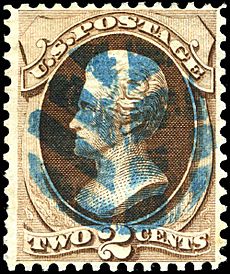Fancy cancel facts for kids
A fancy cancel is a special kind of mark put on a postage stamp to show it has been used. Instead of just a plain circle or lines, fancy cancels have cool artistic designs! These unique marks were mostly made in the 1800s in U.S. post offices, often carved into pieces of cork.
Contents
Why Stamps Needed Cancels
When postage stamps first came out in the U.S. in 1847, there was a new rule. Postmasters had to "cancel" or mark the stamps. This was to stop people from using the same stamp again and again. But the rules didn't say exactly how to do it. So, postal workers often used whatever they had nearby. Sometimes they used pens or old "PAID" stamps from before postage stamps existed.
How Cork Cancels Began
Soon, many post offices started using cork bottle stoppers. They would dip these corks in ink and press them onto the stamps. This worked well, but sometimes the cork would cover the whole stamp. This made it hard to see the stamp's value, called its denomination.
To fix this, clerks got creative! They started carving grooves into the corks. A simple groove across the middle made two half-circles. Then, they added more grooves, like two cuts crosswise, to make a "four-piece country pie." Even more cuts led to the "eight-segment city pie." They also cut notches out of the edges. This made the cancel lighter and easier to see the stamp underneath.
Amazing Artistic Designs
The idea of carving corks really sparked creativity across the country! Soon, thousands of different designs started to appear. These designs were super varied and imaginative. You could find everything from shields to skulls, stars, cool geometric shapes, animals, plants, and even devils with pitchforks!
Some of the most common fancy cancel designs were different kinds of stars and crosses. The Waterbury, Connecticut post office was especially famous for its amazing designs. They made new cancels for almost every holiday and special event!
The Famous Waterbury Running Chicken
One of the most famous fancy cancels is the "Waterbury Running Chicken." It might have actually been a turkey, since it appeared around Thanksgiving in 1869. This special cancel was only used for a few days. Because it's so rare, it's now one of the most valuable 19th-century cancels. Letters with this cancel, called covers by stamp collectors, can sell for very high prices!
The End of an Era
The time of fancy cancels started to end in the 1890s. The Post Office Department decided to make new rules. These rules made cancellations more standard and less artistic. This meant that the unique, hand-carved designs slowly faded away.
Studying Fancy Cancels Today
Even though they are no longer used, fancy cancels are still very popular with stamp collectors, called philatelists. Experts have studied and sorted them into different types. Some designs are quite common and don't cost much extra. But others are very rare and valuable. It's exciting because new, unknown fancy cancels are still being discovered sometimes!
Fancy cancels weren't just a U.S. thing. Many other countries also had them. Outside the U.S., they are usually called cork cancellations. For example, Canadian cork cancellations are well-known for their fancy designs. You can also find cork cancellations on stamps from old British Colonies, like the Cape of Good Hope.



